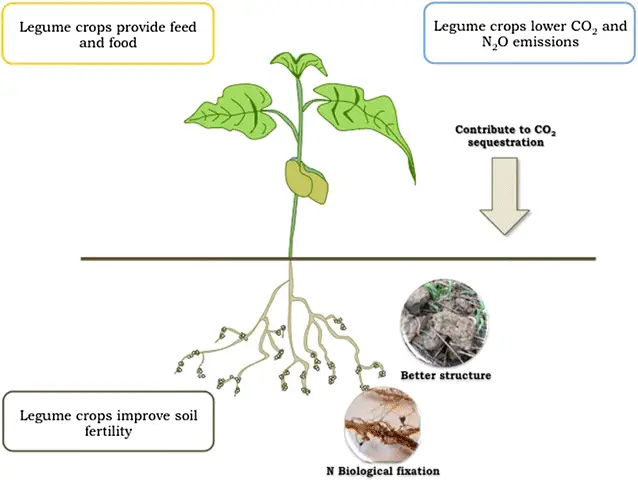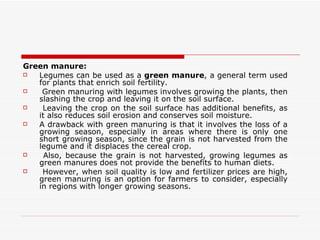Growing leguminous plants in crop rotation is significant because they fix nitrogen in the soil, improving soil fertility and reducing the need for synthetic fertilizers, leading to sustainable and cost-effective farming practices. Legumes have a unique ability to form a symbiotic relationship with nitrogen-fixing bacteria in their roots, converting atmospheric nitrogen into a usable form for plants.
This process enriches the soil with nitrogen, benefitting subsequent crops in the rotation. Furthermore, leguminous plants also contribute organic matter to the soil when incorporated, enhancing its structure and water-holding capacity. By incorporating legumes into crop rotation, farmers can optimize yields, reduce environmental impact, and improve long-term soil health and productivity.
Importance Of Leguminous Plants In Crop Rotation
Leguminous plants play a crucial role in crop rotation due to their various benefits to the soil and overall plant health.
Nitrogen Fixation
Leguminous plants have the ability to fix nitrogen from the air into the soil, providing an essential nutrient for other plants.
Soil Improvement
They help improve soil structure and fertility through root systems that promote aeration and microbial activity.
Pest Control
Leguminous plants can naturally control pests, like nematodes, by producing compounds that repel harmful insects.

Credit: brainly.in
Types Of Leguminous Plants
Leguminous plants, such as peas, beans, and lentils, play a crucial role in crop rotation due to their ability to fix nitrogen in the soil. This helps to improve soil fertility and reduces the need for synthetic fertilizers, benefiting both the environment and the overall health of the crops.
Leguminous plants, also known as legumes, are an essential component of crop rotation due to their numerous benefits for soil health and overall sustainable farming practices. These plants belong to the Fabaceae family and have the unique ability to fix atmospheric nitrogen through a symbiotic relationship with soil bacteria. This nitrogen fixation process improves soil fertility and reduces the need for synthetic fertilizers. Let’s explore some common types of leguminous plants that are commonly used in crop rotation:
Clover
Clover is one of the most popular leguminous plants used in crop rotation systems. It is a low-growing plant with trifoliate leaves and is highly effective in fixing nitrogen in the soil. Clover has deep taproots that help improve soil structure and enhance water retention. This plant also releases organic matter into the soil when it decomposes, enriching it and supporting the growth of subsequent crops. Farmers often sow clover as a cover crop during fall or winter to protect the soil from erosion and suppress weed growth. Additionally, clover attracts beneficial insects like bees, aiding in pollination and promoting biodiversity on the farm.
Soybeans
Soybeans, scientifically known as Glycine max, are another vital leguminous crop frequently included in crop rotation plans. These beans are rich in protein and are extensively used in various food products. Apart from their nutritional value, soybeans contribute significantly to sustainable agriculture. They have a remarkable ability to fix atmospheric nitrogen, making them an excellent choice for improving soil fertility. Soybeans have a relatively short lifecycle, making them suitable for crop rotation schedules. Their deep roots help break up compacted soil, improving its structure and facilitating better nutrient and water absorption. Soybeans are also known to suppress nematode populations, which can be beneficial for subsequent crops susceptible to nematode damage.
Peas
Peas, scientifically called Pisum sativum, are another leguminous crop valued for its nitrogen-fixing capabilities. These plants have a climbing or bushy growth habit, depending on the variety. Peas are commonly grown as a spring or fall cover crop, as they quickly establish and add organic matter to the soil when incorporated. The roots of pea plants contribute to soil aeration, enhancing its overall health. Moreover, the flowers of many pea plant varieties attract pollinators and beneficial insects to the fields. Peas also have deep taproots that help break up compacted soil and improve drainage. Furthermore, they have the potential to suppress weeds due to their dense canopy, reducing the need for herbicides in subsequent crops. In conclusion, leguminous plants, including clover, soybeans, and peas, play a crucial role in crop rotation by improving soil fertility, enhancing soil structure, and reducing the dependency on synthetic fertilizers. These plants not only fix atmospheric nitrogen but also contribute to weed suppression, erosion control, and biodiversity. Including leguminous plants in crop rotation plans helps create a sustainable and environmentally friendly farming system.
Best Practices For Incorporating Leguminous Plants
Integrating leguminous plants into a crop rotation plan offers a multitude of benefits to farmers and the environment. Legumes have the unique ability to fix nitrogen from the atmosphere, enriching the soil with this essential nutrient. In addition to improving soil fertility, leguminous plants can aid in weed suppression, pest control, and disease management. To make the most of incorporating leguminous plants into your crop rotation, follow these best practices.
Crop Rotation Techniques
Crop rotation is a vital component of successful agriculture. By alternating crops in a systematic way, farmers can avoid soil exhaustion, reduce pests and diseases, and promote long-term sustainability. When it comes to incorporating legumes into your crop rotation, consider the following techniques:
- Two-Year Rotation: Implement a two-year crop rotation system where leguminous plants are grown every other year. This allows for proper nitrogen fixation, replenishing the soil for subsequent crops.
- Three-Cycle Rotation: Adopt a three-cycle rotation plan, in which legume crops are grown once every three years. This longer interval ensures maximum nitrogen fixation and provides soil with ample time to recover.
Choosing Suitable Legumes
To maximize the benefits of leguminous plants in crop rotation, it’s crucial to choose suitable legume varieties. Consider the following factors when selecting legumes to grow:
- Environmental Adaptability: Choose legumes that are well-adapted to your region’s climate and soil conditions. This ensures optimal growth and productivity.
- Nitrogen Requirements: Different legume species have varying nitrogen-fixing capabilities. Select legumes that match the nitrogen needs of subsequent crops in your rotation.
- Complementary Crops: Take into account the other crops in your rotation and select legumes that complement them. This includes considering pest and disease interactions, as some legumes have natural resistance to certain pests and diseases.

Credit: chembioagro.springeropen.com
Economic And Environmental Impact
Growing leguminous plant in crop rotation can significantly impact both the economy and environment. These plants enhance soil fertility, reducing the need for synthetic fertilizers, ultimately benefiting farmers financially. Additionally, leguminous plants fix nitrogen in the soil, reducing greenhouse gas emissions and promoting sustainable agriculture practices.
Growing leguminous plants in crop rotation has significant economic and environmental benefits.
Increased Crop Yields
Leguminous plants fix nitrogen in the soil, which enhances soil fertility and improves the overall crop yield.
Reduced Fertilizer Use
By planting leguminous crops in rotation, farmers can reduce the need for synthetic fertilizers, leading to cost savings and environmental sustainability.
Challenges And Considerations
Leguminous plants play a crucial role in crop rotation due to their ability to fix nitrogen in the soil, enhancing its fertility. However, several challenges and considerations need to be addressed for successful integration of leguminous plants in crop rotation.
Crop Compatibility
When selecting leguminous plants for crop rotation, it’s essential to consider their compatibility with other crops in the rotation cycle. Compatibility ensures that the plants complement each other’s growth patterns and nutrient requirements, promoting a harmonious and beneficial rotation system.
Market Demand
The demand for leguminous crops in the market should also be taken into account when incorporating them into crop rotation. Understanding market trends and consumer preferences can help in deciding which leguminous plants to grow for optimal economic returns.

Credit: pt.slideshare.net
Frequently Asked Questions On What Is The Significance Of Growing Leguminous Plant In Crop Rotation?
Why Are Legumes An Important Part Of Natural Crop Rotations?
Legumes are vital in natural crop rotations because they enrich the soil with nitrogen, improving its fertility. This reduces the need for synthetic fertilizers and promotes sustainable agriculture.
What Is The Importance Of Legumes In Crop Production?
Legumes play a significant role in crop production due to their unique ability to fix nitrogen in the soil. This enriches the soil, enhancing its fertility and reducing the need for synthetic fertilizers. Legumes also promote biodiversity, prevent soil erosion, and can be used as a protein source.
What Is The Benefits Of Growing Leguminous Plants?
Growing leguminous plants benefits agriculture by enriching soil with nitrogen, enhancing crop yield sustainability, and promoting biodiversity.
Why Do Farmers Grow Leguminous Crops After Harvesting?
Farmers grow leguminous crops after harvesting to restore nutrients in the soil. Legumes fix nitrogen, enriching the soil for the next crop. This practice promotes sustainable agriculture and reduces the need for synthetic fertilizers.
Conclusion
By incorporating leguminous plants into crop rotation, farmers can improve soil health naturally. This sustainable practice enhances nutrient cycling and reduces reliance on synthetic fertilizers. Overall, growing legumes benefits the environment, boosts crop yields, and fosters long-term agricultural sustainability. Embracing this technique can lead to more resilient and productive farming systems.
